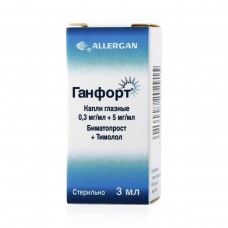Expiration date: 02/2026
Composition and form of release
Ganfort-eye drops:
1 ml. contains bimatoprost 300 mcg, timolol 5 mg, a bottle of 3 ml.
Pharmacological action
Ganfort is a combined drug, its components bimatoprost and timolol reduce intraocular pressure (IOP) due to the combined interaction, leading to a significantly more pronounced hypotensive effect compared to the effect of each of the components separately. Bimatoprost belongs to synthetic prostamides, it is similar in chemical structure to prostaglandin F2? (PGF2?). Bimatoprost does not affect any of the known types of prostaglandin receptors. The hypotensive effect of bimatoprost is carried out by increasing the outflow of intraocular fluid through the trabecula and along the uveoscleral pathway of the eye. Timolol is a non-selective beta-adrenoblocker, does not have internal sympathomimetic and membrane-stabilizing activity. Timolol reduces IOP by reducing the formation of intraocular fluid. The exact mechanism of action is not established, perhaps it is associated with the inhibition of the synthesis of cyclic adenosine monophosphate (c-AMP) and is caused by endogenous stimulation of beta-adrenergic receptors.
Indications
Reduction of intraocular pressure (IOP) in patients with open-angle glaucoma and intraocular hypertension with insufficient effectiveness of topical use of beta-blockers and prostaglandin analogues.
Contraindications
Hypersensitivity to the components of the drug. The syndrome of increased reactivity of the respiratory tract, including acute bronchial asthma and previous episodes in the anamnesis, severe chronic obstructive pulmonary disease (COPD). Sinus bradycardia, atrioventricular block of II and III degrees, clinically pronounced heart failure, cardiogenic shock. Age up to 18 years. Pregnancy, breast-feeding period.
Method of administration and dosage
Recommended doses in adults (including elderly patients). One drop is instilled into the conjunctival sac of the affected eye 1 time a day in the morning. If the administration of the drug is skipped once, the drug is administered the next day. It is not recommended to exceed the dose-1 administration 1 time a day. If more than 2 drugs are used, it is necessary to take a 5-minute break between instillations.
Side effects
The frequency of side effects identified during the studies was estimated as follows: very often ( > , 1/10), often (>, 1/100, <, 1/10), infrequently (>, 1/1000, <, 1/100).
In clinical studies of the drug Ganfort, the following side effects were identified:
From the central nervous system: infrequently-headache.
From the side of the visual organ: very often – conjunctival hyperemia, eyelash growth, often – superficial keratitis, corneal erosion, burning sensation, itching, burning pain in the eyes, foreign body sensation, dryness of the eye mucosa, redness of the eyelids, eye pain, photophobia, eye discharge, visual impairment, itching of the eyelid skin, infrequently – iridocyclitis, irritation of the eye mucosa, conjunctival edema, blepharitis, epiphora, swelling of the eyelids, eyelid soreness, decreased visual acuity, asthenopia, trichiasis, frequency unknown – cystic macular edema.
From the respiratory system: infrequently-rhinitis.
From the skin and subcutaneous fat: often - pigmentation of the eyelid skin, infrequently-hirsutism.
Special instructions
Just like other ophthalmic medications, Ganfort can enter the systemic bloodstream. Symptoms of heart failure should be compensated before using the drug Ganfort. It is necessary to regularly monitor the condition of patients with severe heart failure, determine the heart rate. When using timolol, there were reports of side effects from the cardiovascular system and respiratory organs, including deaths due to bronchospasm in patients with bronchial asthma, as well as (less often) from heart failure. Beta-blockers can mask the symptoms of hypoglycemia, hyperthyroidism and cause deterioration of the course of Prinzmetal angina, severe peripheral and central vascular disorders, as well as arterial hypotension. In patients with a history of atopic manifestations and severe anaphylactic reactions to various allergens, doses of epinephrine (adrenaline), which are usually used to stop anaphylactic reactions, are used. In patients with mild liver disease or initially increased activity of liver enzymes – alanine aminotransferase (ALT), aspartate aminotransferase (AST) and/or total bilirubin, bimatoprost did not affect liver function during the study period of more than 24 months. Before starting treatment, patients should be informed about the possible growth of eyelashes, increased pigmentation of the skin of the eyelids and pigmentation of the iris of the eyes, since these side effects were established during studies of bimatoprost and the drug Ganfort.
Storage conditions
At a temperature not exceeding 25 °C. Keep out of the reach of children.
The shelf life is 2 years.
Ganfort
(Bimatoprost
+
Tymolol)
eye
drops
- Brand: Allergan


